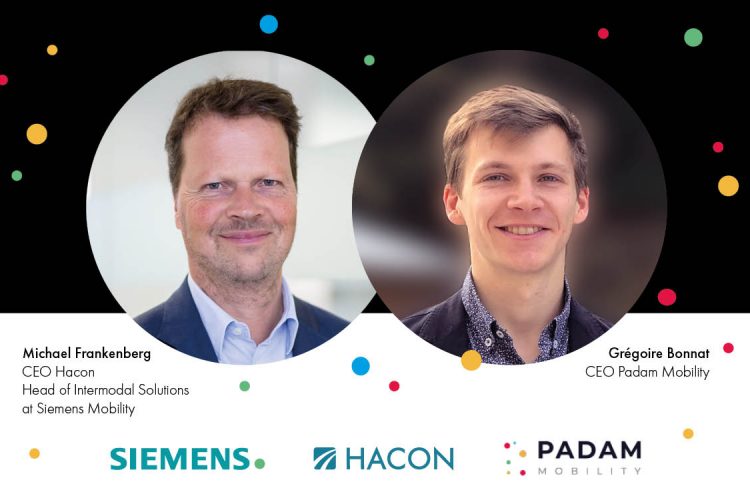No on-demand transportation, no MaaS!
- Like
- Digg
- Del
- Tumblr
- VKontakte
- Buffer
- Love This
- Odnoklassniki
- Meneame
- Blogger
- Amazon
- Yahoo Mail
- Gmail
- AOL
- Newsvine
- HackerNews
- Evernote
- MySpace
- Mail.ru
- Viadeo
- Line
- Comments
- Yummly
- SMS
- Viber
- Telegram
- Subscribe
- Skype
- Facebook Messenger
- Kakao
- LiveJournal
- Yammer
- Edgar
- Fintel
- Mix
- Instapaper
- Copy Link
Posted: 11 August 2021 | Hacon - A Siemens Company | No comments yet
Padam Mobility’s CEO, Grégoire Bonnat, and Michael Frankenberg, Hacon’s CEO and Head of Intermodal Solutions at Siemens Mobility, discuss their cooperation and plans for the future.


Padam Mobility is a leading provider of Software-as-a-Service (SaaS) solutions and develops artificial intelligence (AI) supported platforms and applications for on-demand transportation and paratransit services. The Paris-based company has been an official part of the Siemens Mobility family since May 2021 – after almost three years of successful cooperation. In this interview, Padam Mobility’s CEO, Grégoire Bonnat (GB), and Michael Frankenberg (MF), Hacon’s CEO and Head of Intermodal Solutions at Siemens Mobility, discuss their cooperation and plans for the future.
What role do on-demand services play as part of the door-to-door journey?
MF: On-demand shuttles are ideal for routes that are not served by public transport, in areas where a timetable-based offer would simply not be economical. This way, they help to bridge the service gaps in off-peak times and low-populated regions, as well as on the first and last mile. On-demand services are cost-efficient for operators and convenient for passengers: rural residents, for example, can take the shuttle bus to the next train station. On-demand services are also highly beneficial for people with limited mobility or as transport solutions for large factory campuses.
What exactly do transport companies get from integrating on-demand services into their existing offer?
GB: Public transport can only really compete with private transport when the offer is right! The market is increasingly acknowledging that integrated on-demand services are a useful and attractive supplement to the traditional, timetable-based public transportation system. They give public transport companies the opportunity to expand their service areas and create tailor-made offers for their customers. For this purpose, our algorithm offers various combinable operating models, from fixed line services to flexible feeders and fetchers – this allows us to meet individual local requirements.
Mobility-as-a-Service platforms integrate a wide variety of data and interfaces into one comprehensive trip planner. How does MaaS benefit from on-demand services?
MF: In our opinion, intelligently orchestrated on-demand transportation represents an essential component of a successful MaaS strategy. Hacon apps already allow intermodal routing across a wide variety of modes. The goal for us is always to offer a digital, seamless and completely integrated travel experience from door to door: from public transport to on-demand and new mobility – we combine different services, various modes of operation and multiple providers. All of these are centrally managed and made available via the user app. Different apps for public and on-demand transport are no longer necessary. Instead, passengers get one convenient mobility app that turns plan, book, pay and travel into reality. This is the only way to offer a real alternative to your own car and encourage people to switch to public transport.
What about your strategic product plans?
MF: We see a lot of potential for the future and great synergy effects with the existing portfolio of Hacon, eos.uptrade, Bytemark and Siemens Mobility. We will closely link Padam’s solutions to our fleet management system: HAFAS Smart VMS will then support both scheduled and demand-responsive transportation (DRT). This also enables reliable connections across all modes of transport: if a train or bus is delayed, the shuttle has to wait. The other way around, too, we have to guarantee that the shuttle reaches the connecting train or bus in time.
GB: We have ambitious goals: reconnecting territories; making mobility policies more impactful in the low and mid-density areas; and offering modern paratransit services. But, most importantly, we do not want to compete with public transport! It carries passengers in a sustainable, climate-friendly way, and on-demand shuttles can help to make the offer more attractive. Our ‘non-competition’ feature is a key to success: systems are interfaced so that on-demand rides do not compete with, but only compliment fixed bus rides. That way, on-demand services are available where fixed are not and can be more attractive than using private cars. Where scheduled public transport is already going strong, on-demand offers will only fill gaps to achieve a better overall availability of public transport in a very cost-efficient way.
MF: Together with Padam Mobility and our Siemens Mobility colleagues from the Shared Autonomous Mobility (SAM) team, we will also increasingly focus on and promote the future topic of autonomous on-demand shuttles, so that cities and public transportation providers will soon be even more competitive, with efficient solutions for the first and last mile. Last but not least, we will combine our competencies in the areas of data analytics and simulations for an even broader range of services for our customers.
Padam Mobility was founded in 2014 and is headquartered in Paris. Padam Mobility’s Demand Responsive Transport (DRT) platform is a white-label software suite used by public transport operators to add microtransit and paratransit services to their offering. Padam currently has approximately 50 employees.
Related topics
Artificial Intelligence, Mobility Services, Multimodality, Passenger Accessibility, Passenger Experience, Public Transport, Ticketing & Payments, Travel & Passenger Information
Related organisations
Hacon A Siemens Company, Padam Mobility, Siemens Mobility
Related people
Grégoire Bonnat, Michael Frankenberg








